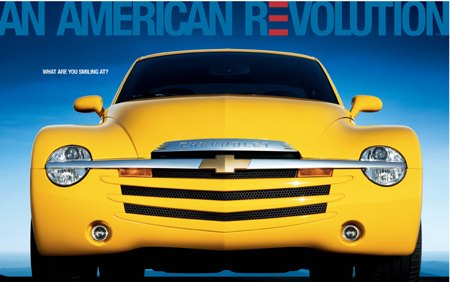GM's New Brand Strategy: Chevy Uber Alles
While most enthusiasts recognize the philosophy behind Sloan’s GM brand structure, few realize that each company within the GM fold used to have just ONE car in its line-up. Even during the 50’s, in the middle of GM’s “golden years,” each brand had no more than two wheelbases and three body styles. With such a limited number of models within each brand, overlap was minimal. Moving “up-market” was simple enough; you took your old car and your new money to a different dealer.
When GM started adding new models, expanding their offerings to cover bases like “compact car,” “utility vehicle” and “minivan,” they altered the dynamics of their business. Despite this horizontal model spread, GM tried to hew to a vertical brand system. Buick and Olds stayed true to their roots, offering two to three big cars (aside from the Cadet experiment). But Chevy and Pontiac became their own worst enemies. Chevy dealers currently sell over a dozen different vehicles over a wide spectrum of price points, from $10k econoboxes to a wide range of pickups to $70k sports cars. At the same time, Pontiac’s place in GM’s firmament has become unclear.
The problem isn’t so much the sheer spread of vehicles– most companies’ “main” brands spread as far. The problem is that Chevy is still selling only discount cars, even though it embraces up-market price points. GM’s other divisions also have a discombobulated product mix. Pontiac exists in the gaps above each Chevy price point. Cadillac is still perched at the top of the market, but their line shows little commonality (save a bit of “bling” here and there). Product overlap is endemic for all divisions. Actually, it isn’t so much overlap as “strangulation”. Chevy is trapped under the new trinity of Pontiac/Buick/GMC. For every Chevy, there’s one or more up-market counterparts it dare not exceed.
Where once you chose your GM car with your pocketbook, now it’s more a matter of taste. GM’s website illustrates the point perfectly; enter a price range into the “shop by price function” and you get a list of differently-sized models and vehicle types across several brands. If a GM car buyer wants a certain type of vehicle or a vehicle at a given price, they have to shop at least two and quite possibly four GM brands’ dealers to see all their choices. Otherwise, they could end up being steered to an inappropriate vehicle– and we all know what that does to a brand.
Acting like it’s still 1955 has left GM with a huge product line that’s full of holes, along with “boutique” brands scattered about like polka dots. This so-called strategy’s lack of focus robs Chevy of the quality it needs to be a reasonable alternative to the price-sensitive end of their “foreign” competition. It restricts Pontiac, GMC and Buick to marketing cars “better than Chevy” (a standard that keeps slipping lower). It detaches Cadillac, Hummer and Saab from the ownership ladder. In fact, GM’s brands don’t just steal sales from each other; they pull each other into a pit of mediocrity.
GM’s oversized dealer network makes the problem worse– and solutions problematic. One answer: make some of the marques into models. Instead of trying to keep Buick and Pontiac alive with a tiny line-up and a huge dealer network, GM could fold their products into Chevy’s portfolio. The top trim sedans in the largest two sizes could be called Buicks, while a Pontiac would denote a performance model (the GT’s not the SS’s). GMC could go back to its commercial customers.
This brand consolidation would allow GM to offer a car for every “purpose” and most “purses” under a single roof. Alfred Sloan would spin in the grave at the idea, but it just might work.
More by Andrew Dederer
Latest Car Reviews
Read moreLatest Product Reviews
Read moreRecent Comments
- Ajla A union fight? How retro 😎
- Analoggrotto Finally, some real entertainment: the Communists versus the MAGAs. FIGHT!
- Kjhkjlhkjhkljh kljhjkhjklhkjh *IF* i was buying a kia.. (better than a dodge from personal experience) .. it would be this Google > xoavzFHyIQYShould lead to a 2025 Ioniq 5 N pre-REVIEW by Jason Cammisa
- Analoggrotto Does anyone seriously listen to this?
- Thomas Same here....but keep in mind that EVs are already much more efficient than ICE vehicles. They need to catch up in all the other areas you mentioned.


































Comments
Join the conversation
KingElvis, what's with all the pushrod motors? And why not have engine options? Maybe not dozens but two or three. People have different needs, make different choices available. Let's bring back final drive ratios as options, too. I'm fairly certain that my Dad had a choice of engines and final drives on his '69 Ford wagon (the only car I saw him buy new, a choice he regretted forever after). I believe the options were an I-6 of some sort, a 302, a 351 (his choice), a 390 and a 429. Of course, if you're going to have engine options, it would be best if they were all good engines.
The idea is to make the brands more "exclusive" by restricting engines to certain models and/or brands. It's part and parcel of preserving Buick and Pontiac - they have to offer something you can't get on a Chevy.